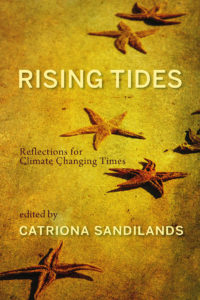 In the few weeks it has taken me to read and review Rising Tides: Reflections for Climate Changing Times (Caitlin Press, 2019), the world has all but forgotten the climate crisis. It is March 2020. Headline stories of wildfires and floods have slipped to the bottom of news websites or disappeared completely. We are consumed by another—seemingly separate—crisis: COVID-19.
In the few weeks it has taken me to read and review Rising Tides: Reflections for Climate Changing Times (Caitlin Press, 2019), the world has all but forgotten the climate crisis. It is March 2020. Headline stories of wildfires and floods have slipped to the bottom of news websites or disappeared completely. We are consumed by another—seemingly separate—crisis: COVID-19.
But as contributors to Rising Tides show, as all nature writers show, few things are truly separate. A virus moves from wildlife to humans and then, within months, is transported around the world. Is COVID-19 different from the climate crisis, or are both symptoms of a larger problem: our unyielding consumption and exploitation of nature?
Rising Tides is a collection of poetry, fiction, and essays that originated in a workshop on Galiano Island, British Columbia. Most of the forty-plus contributors are from Canada’s west coast; many others are from Ontario, and a few write from the east coast. Despite their range of geographic location and writing genre, Rising Tides’ contributors are united in their portrayal of a world already altered by climate change. Their writing is not speculative, as editor Catriona Sandilands notes in her introduction, but rather bears witness to what we have already lost and what we continue to lose. Right now, every day.
The collection begins with Rosemary A. Georgeson’s “A Lifetime with Bulb Kelp.” The poem tells of her own fifty years on the BC coast where bulb kelp beds have been medicine, habitat for food, and guidance for moving along the coast. With warming waters and increased boat traffic, however, those beds are almost gone. “What used to be and what is today,” Georgeson writes. A stark contrast within one lifetime.
Suzanne Fournier’s essay, “Are We Facing the Death of the Tree of Life?”, combines science, anthropology, Traditional Knowledge, and memoir to describe the loss of cedar trees on Galiano Island. Trees that are “a cultural keystone species” are now “literally drowning from drought…. Entire stands of cedar can be seen withering and turning brown.”
Many contributors to Rising Tides tell similar stories of loss. Jamie Snook describes the loss of ice in Labrador, a phenomenon Inuit people of this area have experienced and documented for decades. Sara Barron writes about urban cherry trees in Victoria, BC, where drought and warmer temperatures threaten the “spring ritual of blossom ‘snow’.” Holly Schofield offers five ways to talk about twisted oak moss, a “meek and unassuming” species whose absence is nonetheless portentous.
It is vital that we recognize such loss but of course recognition is not enough. None of the authors in Rising Tides is complacent. In various ways, these writers also document what is growing stronger throughout the climate crisis—and what we need in any crisis. Humility, creativity, hope, connection.
In their co-authored reflection, Deborah McGregor and Hillary McGregor consider the loss of maple trees and the vital, ancient tradition of making maple syrup. “It is easy to become disheartened,” they write. “But then I remember the Eagle.” McGregor and McGregor implore us all to remember our non-human relatives and the stories they teach: “We need to remember that it is with humility that we must breathe life into our responsibilities and obligations to the continuance of life. We have to act on the stories being told by the earth.”
As for creativity, Rising Tides itself is testament to its power. Because the writing is compelling and original, chapters such as “All on the Same Train: Bringing Home the Paris Agreement” by Christopher Campbell-Duruflé, “Key to the Conifers of Galiano Island, 2150” by Lauren Magner and Andrew Simon, and “Keeping Watch at Kwekwecnewtxw” by Rita Wong and Emily Griffin prompt us to ask further questions, dig deeper, learn more. What does the Paris Agreement actually say? How do taxonomic keys work? What is happening at the Kwekwecnewtxw watch house?
Most evident throughout Rising Tides is a lifeline of hope. Carleigh Baker’s fictional “Where Were You?” takes us back to the 1980s when Aqua Net-stiffened hairdos raised everyday awareness of CFCs and ozone depletion. The setting of the story seems long ago—in part because the world came together and took action in the form of the Montreal Protocol. Change is possible.
All of the writers here show why, especially in times of crisis, literary writing is essential. It can foster understanding and empathy. It can help us imagine a better way forward. As Rita Wong and Emily Griffin conclude:
The struggles here and elsewhere
are connected by a truth:
we must become better relatives
with the earth. With each other.
We cannot afford
the alternative.

